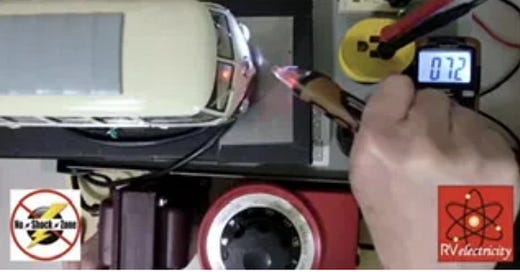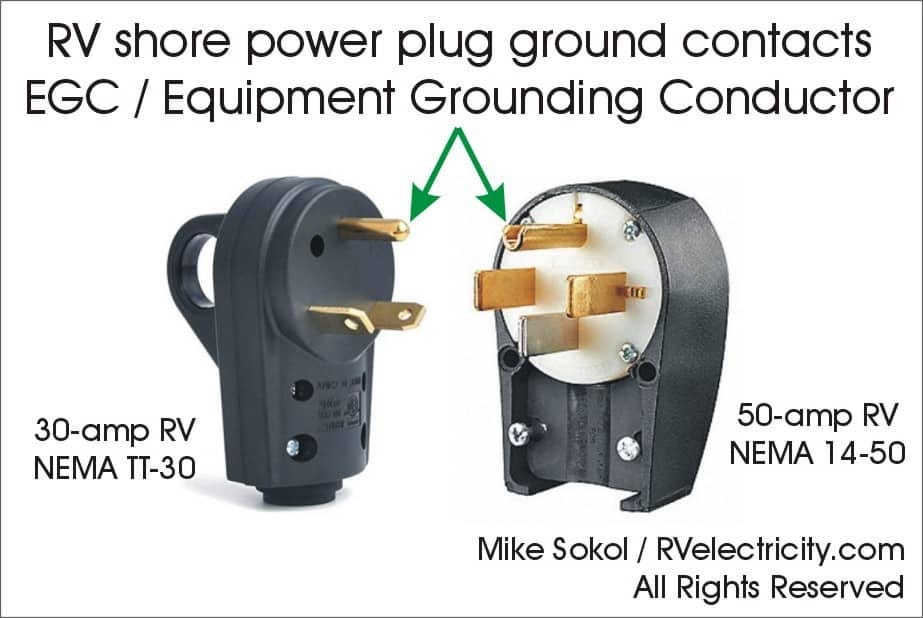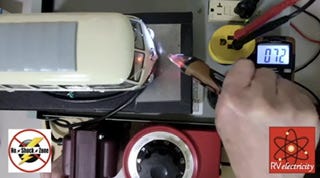Dear Mike,
About two years ago we were camping at a State Park. I noticed a family camped a few spaces away with 2 or 3 young children and 2 women and a dog.
The dog refused to go up the steps into the camper and cried. The kids ran in and out which upset the dog. It didn't look right to me so I walked down to talk with the adults.They were trying to get the dog into the camper and the dog was refusing. I noticed that everyone was wearing rubber soled shoes except the dog.
I got out my meter and non-contact tester and checked the steps to the camper. They were electrified! One of the women checked the power pedestal and found that the 20-amp circuit breaker, 30-amp circuit breaker, and the 50-amp circuit breaker were all switched on. They were only plugged into the 20-amp circuit breaker. She switched off the 50-amp and 30-amp circuit breakers and the hot-skin voltage disappeared.
Good dog! - Ralph C
Dear Ralph,
Great observation and action on your part! I think that everyone who camps in an RV should have a Non-Contact Voltage Tester and know how to use it!
But I should note that having the 30 and 50-amp circuit breakers on while using only the 20-amp outlet generally has nothing to do with the actual cause of the hot-skin voltage. I suspect there was some dangerous connections inside of the pedestal done by someone who had no business working on pedestal wiring. But more on that later…
Here’s a quick review of what a hot-skin/stray-voltage is…
Normally, the skin and chassis of your RV is within 5 to 10 volts AC of the earth ground potential. It’s the job of the ground wire in your shore power cord and pedestal to keep it down to this safe voltage level. And the only thing that can cause that 5-volt ground offset is the power company’s imbalance of 3-phase incoming power that can sometimes show up as ground currents that bias the neutral bus a few volts. But that’s a complex topic for engineers and power company personnel to consider.
However, if the ground wire is loose or broken in your electrical connection back to the service panel bonding point, the RV chassis voltage can rise to 30, 60 or even 120 volts. Anything over 30 volts can be very dangerous to your heart, so if you detect 10 to 30 volts or more, then you should disconnect your RV from shore power immediately until the problem can be corrected.
How NCVT testing works….
I came up with this very simple NCVT (Non-Contact Voltage Test) proximity test 15 years ago, but the manufacturers still haven’t included it in their owner’s manuals, which is why you haven’t read about it already. But you can watch the video showing how it works by clicking HERE or on the picture below.
How this works…
I’m showing a desktop 120/240-volt pedestal with a variable AC transformer, a metal VW micro-bus model, and several different Non-Contact Voltage Testers that I always recommend for my readers. Of course there are other brands and models of non-contact testers that will work, but let’s keep it simple for now.
So I can recommend the following testers, many of which are available at Lowe’s and Home Depot, as well as Amazon. I have all of these Non-Contact Voltage Testers on my FunkWorks Lab bench, and have done dozens of hot-skin voltage tests on each one. Here’s links to them on Amazon.
Fluke VoltAlert 1AC-A II rated for 90 to 1,000 VAC
Klein NCVT2P rated for 12 to 1,000 VAC (dual range)
Southwire 40116N rated for 100 to 600 VAC
Southwire 40150N rated for 12 to 1,000 VAC (dual range)
Even though many of these testers are rated to find conductor potentials higher than 50 or even 90 volts, they all work great at finding a hot-skin voltage as low as 30 or 40 volts on something as large as a campground pedestal or your RV.
Watch the video above to see a Southwire NCVT in action.
Let’s stay safe out there… Mike








